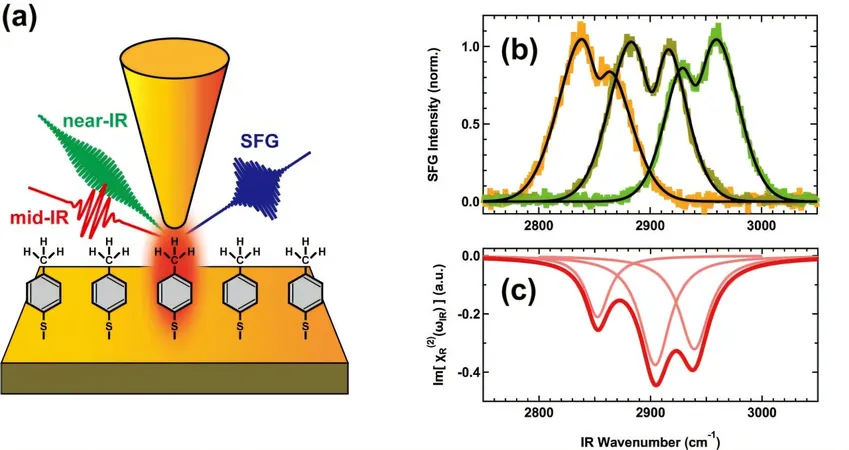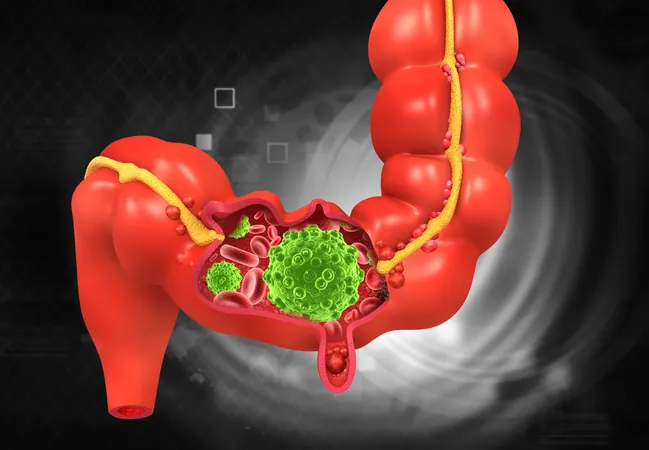
Revolutionizing Surface Science: Nanoscale Spectroscopy Unveils Molecular Secrets in Tiny Gaps
2025-05-12
Author: Daniel
Unlocking the Mysteries of Molecular Dynamics
In a groundbreaking leap for nanotechnology, researchers have harnessed a novel technique known as tip-enhanced vibrational sum-frequency generation (TE-VSFG) spectroscopy to peer deeper into the molecular structures and dynamics of surface systems than ever before. This revolutionary method allows scientists to overcome the limitations posed by traditional far-field observations, which are hindered by the diffraction limit of light.
The Power of Tip-Enhanced Spectroscopy
Led by an innovative team from the Institute for Molecular Science, the researchers integrated TE-VSFG spectroscopy with scanning tunneling microscopy (STM). This powerful combination enabled the detection of vibrational signals emanating from molecules adhered to a gold substrate, even in ambient conditions. Their findings, which have been published in the prestigious journal Nano Letters, mark a significant advance in nonlinear optical nanospectroscopy.
How It Works: The Science Behind TE-VSFG
VSFG spectroscopy is a cutting-edge technique that involves illuminating a sample with both infrared (IR) light, which resonates with specific molecular vibrations, and visible or near-IR light. This intersection generates unique vibrational signatures, revealing information about the molecular composition at the surface. Crucially, TE-VSFG’s enhanced resolution allows researchers to focus on these signals within the intimate confines of the nanogap created by the STM tip and the sample.
Breakthrough at the Nanoscale
The researchers discovered that when the STM tip was merely 50 nanometers away from the substrate, vibrational signals were virtually nonexistent. However, as the tip moved closer—within just 1 nanometer—a wave of VSFG signals emerged. This phenomenon underscores the extraordinary effect of near-field enhancement and the antenna effect at play, which concentrates IR light at the tip apex and boosts emission efficiency.
Unraveling Molecular Orientation
The study revealed three distinct vibrational features characteristic of terminal methyl groups in the molecules being studied. By carefully tuning the mid-IR wavelength and capturing multiple spectra, the scientists could determine the absolute orientation of the molecules—knowledge that is pivotal for understanding chemical reactivity and functionality. In fact, the data showed that the hydrogen atoms of these terminal methyl groups angled away from the substrate, presenting new insights into molecular orientation.
Paving the Path for Future Innovations
This research is not just a theoretical exercise; it’s a gateway to practical implications in fields like heterogeneous catalysis. The ability to detect vibrational signals from a select few molecules confined to such minuscule regions could transform our understanding of surface chemical processes. As scientists aim for advanced applications, this technique opens doors to single-molecule ultrafast spectroscopy and ultra-high spatial resolution molecular imaging, promising to reshape the landscape of surface science.
Conclusion: A Bright Future Ahead
With full realization of these capabilities, researchers are poised to significantly enhance our comprehension of how molecules behave at surfaces, which could lead to the development of new, highly active catalytic materials. This pioneering work not only enriches the field of surface science but also stands as a testament to human ingenuity in the quest to unveil the unseen.



 Brasil (PT)
Brasil (PT)
 Canada (EN)
Canada (EN)
 Chile (ES)
Chile (ES)
 Česko (CS)
Česko (CS)
 대한민국 (KO)
대한민국 (KO)
 España (ES)
España (ES)
 France (FR)
France (FR)
 Hong Kong (EN)
Hong Kong (EN)
 Italia (IT)
Italia (IT)
 日本 (JA)
日本 (JA)
 Magyarország (HU)
Magyarország (HU)
 Norge (NO)
Norge (NO)
 Polska (PL)
Polska (PL)
 Schweiz (DE)
Schweiz (DE)
 Singapore (EN)
Singapore (EN)
 Sverige (SV)
Sverige (SV)
 Suomi (FI)
Suomi (FI)
 Türkiye (TR)
Türkiye (TR)
 الإمارات العربية المتحدة (AR)
الإمارات العربية المتحدة (AR)